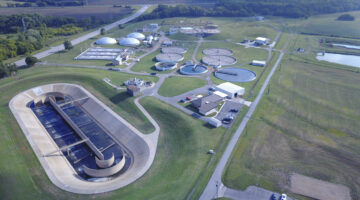For over 100 years, wastewater treatment plants have used anaerobic digestion, a process that turns organic waste into biogas, a renewable energy source. This process stabilizes harmful pathogens, reduces odors, decreases biosolids volume, helps create cleaner water and reduces harmful waste.
How Thermal Hydrolysis Works
Thermal hydrolysis is a high-temperature, high-pressure process that pretreats sewage sludge before anaerobic digestion. It breaks down organic material into soluble substrates, making it easier to convert into biogas while reducing waste volume.
Here is a step-by-step breakdown of the process:
- Sludge Collection and Screening – Organic waste from wastewater treatment is collected and screened to remove debris.
- Dewatering – The sludge is partially dried to remove excess water before being treated.
- Thermal Hydrolysis Process (THP) Treatment – Sludge is exposed to high pressure and temperatures (around 320 degrees Fahrenheit /160 degrees Celsius) for about 30 minutes. This step:
-
- Breaks down complex organic matter
- Destroys harmful pathogens
- Makes sludge easier to digest in the next phase
- Anaerobic Digestion – The treated sludge is fed into anaerobic digesters, where microbes break it down further, producing biogas.
- Energy and Byproducts – The biogas can be used for:
-
- Electricity generation
- Renewable natural gas (RNG) production
- Heat recovery for the THP system
- Final Solids Processing – The remaining solids are further processed into Class A biosolids, which can be used as organic fertilizers and soil amendments.
Why THP is a Game-Changer
- Faster Processing – Unlike traditional digestion, where the disintegration and hydrolysis steps of anaerobic digestion can take weeks, THP treats sludge in just 30 minutes.
- Higher Biogas Yields – More organic matter is broken down, leading to increased biogas production
- Reduced Sludge Volume – Less waste means lower disposal costs and less reliance on landfills
- Sustainability and Revenue Generation – THP produces valuable Class A biosolids, biogas and renewable energy credits, making it financially viable
Challenges in Wastewater Treatment
Even though anaerobic digestion (a method of breaking down waste without oxygen) is common in the U.S., there are still challenges such as:
- Foam and odor issues
- Difficult waste disposal rules
- Low-quality biogas output
Only nine thermal hydrolysis systems exist in the U.S. today, but this number is growing as more plants realize the benefits of the process.
The Franklin Wastewater Treatment Plant
One of the most notable examples of THP in action is the Franklin Water Reclamation Facility (WRF). Located in Tennessee, Franklin WRF is a 16-million gallon per day (MGD) facility that plays a crucial role in regional wastewater treatment. However, like many treatment plants, it faced significant staffing challenges when transitioning to new THP technology.
How Kiewit Helped Franklin WRF Overcome Staffing Challenges
When Franklin WRF introduced THP, it quickly became clear that the facility lacked the experienced staff needed to properly operate and maintain the system. This is a common issue when implementing new and complex technologies. Without proper training and operational support, facilities can struggle with:
- Understanding how THP integrates with existing treatment processes
- Managing the increased biogas production safely and efficiently
- Optimizing sludge dewatering and disposal
- Maintaining the new high-temperature, high-pressure equipment
Kiewit, a leader in infrastructure and wastewater treatment projects, stepped in to support the facility. Kiewit provided on-site personnel, process engineers and training specialists to work alongside Franklin WRF’s operations staff.
Training and Operational Support
Through hands-on experience and structured training, Kiewit helped Franklin’s staff:
- Understand the function and purpose of each piece of equipment
- Optimize biogas capture and use for energy production
- Improve process efficiency and reduce waste volume
- Develop long-term maintenance strategies to ensure system reliability
A new system like thermal hydrolysis requires proper training to ensure operators understand how it works and how to handle challenges. Kiewit implements steps of the AURA training program to help operations and maintenance (O&M) staff successfully manage the system from the start.
Key Elements of AURA Training
- Awareness – Operators need to understand what thermal hydrolysis is and why it is essential for wastewater treatment. The utility and project directors work together to define the skills and knowledge required for success.
- Understanding – Since many wastewater operators are already working full-time schedules, training must be efficient and focused. AURA helps staff:
- Learn what processes and equipment require regular maintenance
- Identify which tasks should be handled by contractors
- Develop hands-on skills to work with instruments such as:
- Instrumentation calibration
- SCADA (Supervisory Control and Data Acquisition) programming
- Motor Control Center panels
- Emergency generators and boilers
- Retention – Since thermal hydrolysis is new to most operators, practical experience is crucial. O&M staff have direct, on-site training rather than just classroom learning to retain and put into practice training protocols. This approach ensures operators:
- Gain confidence in handling real equipment
- Can troubleshoot and fix issues before they become major problems
- Understand how the system interacts with other treatment processes
- Application and Continuous Learning – Learning doesn’t stop after the initial training. The utility and project team continuously review the training’s success and adjust methods as needed. AURA also provides ongoing training opportunities, which:
- Reduce errors in operation
- Improve team communication
- Help operators adapt to changes in technology
How AURA Ensures a Smooth Startup
One of the biggest challenges in wastewater treatment is staff shortages and the need for specialized knowledge when starting a new system. During the Franklin WRF project, it became clear that additional support was needed. AURA training helps facilities avoid common startup issues, such as:
- Misunderstanding how equipment operates
- Inconsistent processes leading to system inefficiencies
- Delays due to improper maintenance scheduling
With AURA, the training is built into the work schedule, so operators learn while they work. This reduces the need for overtime and ensures consistent, high-quality performance from day one.
About the Author:
Steven Greseth is Kiewit’s market director of wastewater and biosolids technology. With nearly 30 years of expertise in the industry, Steven has led numerous large, complex and collaborative water and wastewater projects throughout North America and Europe.


